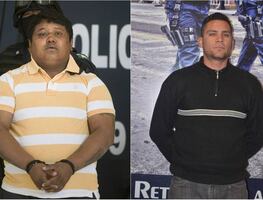Más Información

Osiel Cárdenas, exlíder del Cártel del Golfo, recibe auto de formal prisión; enfrentará juicio por homicidio

Jóvenes mexicanos pasan más de 2 mil horas al año en el teléfono; OCDE alerta sobre su impacto en la salud mental

Sergio Gutiérrez Luna destaca aprobación de 25 reformas en la 66 Legislatura; "Un logro histórico para la 4T", señala

Secretario de Agricultura reafirma defensa del maíz blanco; "Seguiremos apoyando la producción nacional no transgénica", afirma

¿Maíz transgénero? Rubén Rocha corrige desliz durante discurso en Sinaloa; destaca importancia del maíz blanco

Sheinbaum asegura apoyo total a Sinaloa para enfrentar violencia; "Nunca los vamos a dejar solos, aquí está la presidenta"
Conviction
, talent , and originality converge in Swingfónica , a jazz manouche band formed in Mexico City, in 2016.
The band offers an acoustic jazz ensemble that brings together the European take on swing, initiated by Gypsy guitarist Django Reinhardt , and saxophone jazz from the 1930s onwards, with Billie Holiday 's jazz singing style.
In an interview with EL UNIVERSAL , young musicians Federico Hülsz , Francisco Muñoz , Enrique Hülsz, and Luz Varela shared their thoughts on the particular jazz style they offer.
What music does Swingfónica play?
A type of traditional acoustic swing that incorporates various saxophone jazz styles with Billie Holiday’s singing repertoire. It has to do with jazz manouche, which was developed by guitarist Django Reinhart, based in France for most of his life.
Do you find it challenging to merge various jazz styles in your music?
The complexity lies in finding the points of encounter of the various jazz styles we play to render a piece that is accessible to our audience. In the end, all styles merge and depending on what we want to achieve with each piece, we approach the blend of styles differently.
Unlike other jazz styles that require prior preparation on behalf of the audience, Swingfónica offers the type of swing that reaches a larger and varied public, as noted by jazz singer and vocals at Swingfónica , Luz Varela , “people’s response has been very positive thus far, I think we have been able to draw their attention to a different way of playing this type of music and to move them to continue exploring different jazz styles to some extent . People usually wonder at the way we play jazz without drums and find that they like jazz more than they had given themselves the opportunity to be exposed to it.”
Federico Hülsz
, jazz saxophonist of various styles and jazz manouche saxophone at Swingfónica adds, “we welcome all types of audiences. Sometimes we play at private parties and it is children who first respond to our music. Then you see that elders, people over 60, dance and respond to a style they might have experienced first-hand or that they have simply followed for most of their lives. People from all ages and backgrounds participate in our music.”
What do you want your audience to take with them after your shows?
We hope that the audience gains access to new jazz experiences that will pave the way for an exploration of jazz music in general. Jazz is still not as widespread in Mexico as other music genres are.
How alive is jazz
manouche
in Mexico?
Jazz manouche as a genre has been growing in Mexico, you can tell there has been a growth for the past ten years. It is more common to see people interested in this style of music from an early age, while audiences are becoming larger.
Members of Swingfónica found their way to jazz through different paths, Francisco Muñoz , jazz guitarist and rhythm guitar at Swingfónica , had always been captivated by the sounds of acoustic jazz, he says, “It was through a friend that I got to hear from this jazz manouche band, the band of Fede and Enrique , that incorporated a saxophone. So we went to one of their concerts and talked to Enrique, who became my jazz manouche teacher.”
Brothers Enrique and Federico Hülsz were exposed to jazz music, from an early age, through recordings of jazz legends their father would both listen to and play himself. Federico adds, “my father has a very good ear and he would play songs just by hearing them. My brother and my father taught me how to play some songs, we really had a natural and direct exposure to this type of music."
Enrique Hülsz
, jazz manouche guitarist, and lead guitar at Swingfónica, says, “it was really my brother Fede who routed us into playing jazz as I was more into blues. He began to play the harmonica and later the saxophone... he went straight into jazz after that.”
Luz Varela
recalls, “I was part of a girl’s choir and had an uncle who gave me piano lessons from time to time, nothing formal really. Then I went to an arts and humanities high school program which required us to attend all sorts of musical events for free. Once, I got to see a jazz singer and was both captivated and intimidated by her performance because I felt that it would be very difficult for me to sing like that. I took my time, but eventually, I followed that path.”
All band members have played with each other at some point as part of different jazz projects, it was until last year that they decided to come together for Swingfónica . Enrique Hülsz recalls, “We have known each other for over 10 years, and it was until last year that we decided to launch Swingfónica in August 2016.”
When it comes to naming pioneers of jazz manouche in Mexico the band unanimously points at Enrique Hülsz . His brother Federico notes, “My brother is the seedbed, jazz manouche is a very particular music style, a language which requires of profound study and research. My brother did that.”
He adds, “the thing is, that appearances can be deceiving as most of the jazz produced here in Mexico lacks thoroughness in the process entailed to understand and play this music , it is rather superficial at times. This is more so with jazz manouche, as it is a fairly recent style in Mexico. Some of the people who are currently playing jazz manouche in Mexico know it via my brother, whether because they were his students or are studying with him still.”
Frankie Muñoz
and Luz Varela follow by saying “first-hand information and knowledge of this particular style come directly from Enrique. Bands playing this style in Mexico came after him .”
When asked about his first connection with jazz manouche, Enrique Hülsz says, “my father is a professor at Mexico National Autonomous University (UNAM) where he would buy a couple of second-hand tapes every week many years ago. Once, he came across a tape by Django Reinhart . He loved it and played often. I didn’t understand that music at first, one day I tried to play it on my own and that is how I met him (Reinhardt), I read about him. At some point, I had the chance to go to France and met some gypsies in festivals. With them, I learned, first hand, how to perfect my technique and to correct what I was doing wrong with my style of playing.”
Federico Hülsz
believes that “ real jazz blossoms from authentic roots . When I listen to a musician I like, I listen to his sound and personal touch, but also, I listen to his influences; where he comes from, the oral tradition he has partaken. For me, everything lies in the roots, not so much in the so-called originality. For something to be labeled as jazz, one has to be able to trace its roots and to recognize certain features.”
Luz Varela
notes that authentic jazz reveals itself through “a way of exploring music rather than relying solely upon repertoire . It has to do with certain performing codes that some lack and some offer through their music.”
Enrique considers that it also has to do with the way jazz is learned, “it is very common to play music without having heard the pieces before. During Charlie Parker times you wouldn't have a Fake Book to rely on for interpretation of a certain piece. You wouldn’t play the repertoire unless you heard it and learned it by heart. This happens all around the world, people do not realize the time it takes to play a certain piece, to understand where it comes from and to commit to the musical preparation you need to play this type of music.”
bg




